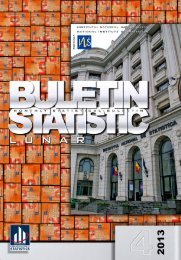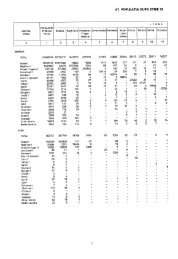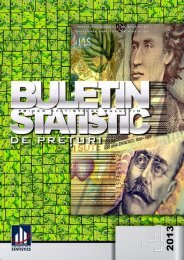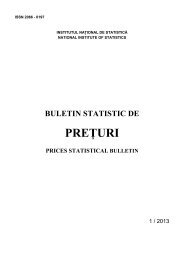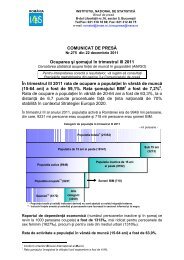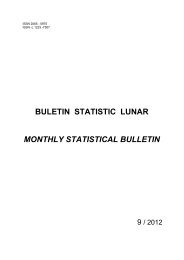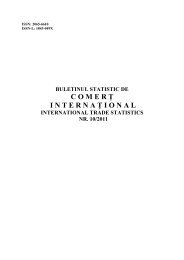buletin statistic de industrie industry statistical bulletin nr. 5/2012
buletin statistic de industrie industry statistical bulletin nr. 5/2012
buletin statistic de industrie industry statistical bulletin nr. 5/2012
You also want an ePaper? Increase the reach of your titles
YUMPU automatically turns print PDFs into web optimized ePapers that Google loves.
eprezentativitate <strong>de</strong> cca 90% la nivel <strong>de</strong><br />
total <strong>industrie</strong> şi minim 80% la nivel <strong>de</strong><br />
diviziune CAEN Rev.2, reprezentativitate<br />
calculată pe baza cifrei <strong>de</strong> afaceri.<br />
Pentru o mai bună reprezentare a<br />
<strong>industrie</strong>i alimentare, datorită specificului<br />
acesteia, în eşantionul <strong>de</strong> întreprin<strong>de</strong>ri<br />
industriale sunt incluse şi societăţile<br />
comerciale cu activitate principală <strong>de</strong><br />
agricultură dar care au subunităţi<br />
specializate în fabricarea produselor<br />
agroalimentare.<br />
Construirea sistemului <strong>de</strong><br />
pon<strong>de</strong>rare şi algoritmul <strong>de</strong> calcul<br />
Agregarea indicilor primari ai<br />
producţiei industriale se realizează<br />
printr-un sistem <strong>de</strong> pon<strong>de</strong>rări succesive,<br />
utilizându-se pentru agregarea la nivel <strong>de</strong><br />
subclasă elementară CPSA - nivel <strong>de</strong><br />
agregare superior al PRODROM-ului<br />
preţul mediu unitar din anul <strong>de</strong> bază<br />
(2005), iar pentru nivelurile <strong>de</strong> agregare<br />
superioare (clasă, grupă, diviziune,<br />
secţiune CAEN Rev. 2 sau mare grupă<br />
industrială) folosindu-se ca element <strong>de</strong><br />
pon<strong>de</strong>rare valoarea adăugată brută la<br />
costul factorilor (VABCF) din anul <strong>de</strong><br />
bază (2005).<br />
Primul nivel <strong>de</strong> agregare este<br />
nivelul clasei CAEN Rev. 2, următoarele<br />
niveluri <strong>de</strong> agregare fiind <strong>de</strong>terminate ca<br />
o medie aritmetică pon<strong>de</strong>rată a indicilor<br />
claselor, grupelor, diviziunilor, secţiunilor<br />
CAEN Rev. 2, marilor grupe industriale,<br />
cu VABCF corespunzătoare din anul <strong>de</strong><br />
bază (2005).<br />
Indicii pentru marile grupe<br />
industriale se obţin prin agregarea<br />
indicilor la nivelul grupelor CAEN Rev. 2<br />
componente, pon<strong>de</strong>rate cu VABCF<br />
corespunzător.<br />
Indicii producţiei industriale pe<br />
total <strong>industrie</strong> se obţin prin agregarea<br />
indicilor calculaţi la nivel <strong>de</strong> diviziune<br />
CAEN Rev. 2.<br />
Pe lângă indicii bruţi ai producţiei<br />
industriale, se calculează lunar şi indici<br />
ajustaţi cu numărul <strong>de</strong> zile lucrătoare prin<br />
metoda regresivă, metodă recomandată<br />
<strong>de</strong> regulamentele europene referitoare la<br />
indicatorii pe termen scurt (Regulamentul<br />
Consiliului 1165/1998).<br />
Pentru ajustarea seriilor (nivel,<br />
diviziune, secţiune, total <strong>industrie</strong> - CAEN<br />
Rev. 2, mare grupă industrială) s-a folosit<br />
pachetul <strong>de</strong> programe DEMETRA<br />
(metoda TRAMO/SEATS), care<br />
realizează estimarea efectului numărului<br />
<strong>de</strong> zile lucrătoare diferit <strong>de</strong> la o lună la<br />
<strong>industry</strong> and minimum 80% at level of<br />
CANE Rev. 2 division, this being<br />
calculated based on turnover.<br />
For a better representation of food<br />
<strong>industry</strong>, due to its specific, the sample of<br />
industrial enterprises also inclu<strong>de</strong>s<br />
commercial companies having agriculture<br />
as their main activity, but which have<br />
subunits specialised in the fabrication of<br />
agro-food products.<br />
Building up the weighting<br />
system and the calculation algorithm<br />
Primary indices of industrial<br />
production are aggregated by a system of<br />
successive weightings, using for the<br />
aggregation at level of CPA elementary<br />
subclass – PRODROM level of upper<br />
aggregation the unit average price of<br />
basic year (2005), while for upper<br />
aggregation levels (CANE Rev. 2 class,<br />
group, division, section or broad industrial<br />
group), being used as weightting element<br />
the gross value ad<strong>de</strong>d at the cost of<br />
factors (GVACF) of the basic year (2005).<br />
The first aggregation level is the<br />
level of CANE Rev. 2 class, the next<br />
aggregation levels being <strong>de</strong>termined as a<br />
weighted arithmetic mean of the CANE<br />
Rev. 2 classes, groups, divisions,<br />
sections indices, the broad industrial<br />
groups, with the corresponding GVACF of<br />
the basic year (2005).<br />
The indices for the broad industrial<br />
groups are obtained by the indices<br />
aggregation at level of the CANE Rev. 2<br />
component groups, weighted with the<br />
corresponding GVACF.<br />
The industrial production indices<br />
per total <strong>industry</strong> are obtained by the<br />
aggregation of indices calculated at level<br />
of the CANE Rev. 2 division.<br />
Besi<strong>de</strong>s gross indices of industrial<br />
production, adjusted indices wiith working<br />
days number are also monthly calculated<br />
by means of regressive method, which<br />
is recommen<strong>de</strong>d by European regulations<br />
regarding the short-term indicators<br />
(Council Regulation no. 1165/1998).<br />
In or<strong>de</strong>r to adjust the series (level,<br />
division, section, total <strong>industry</strong> – CANE<br />
Rev. 2, broad industrial group)<br />
DEMETRA programs package<br />
(TRAMO/SEATS method) was used,<br />
estimating the effect of working days<br />
number different from one mounth to<br />
102



